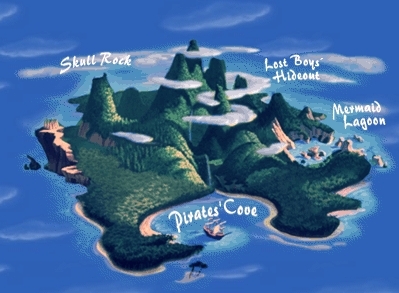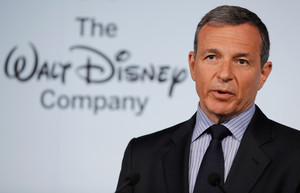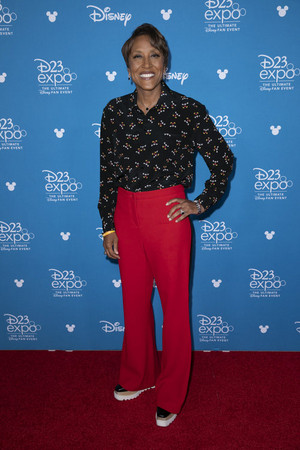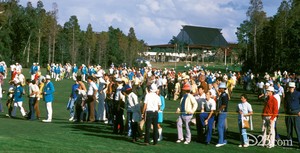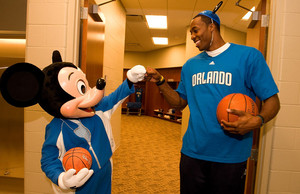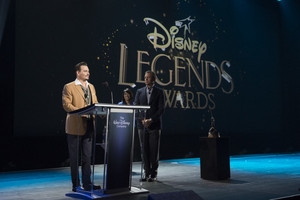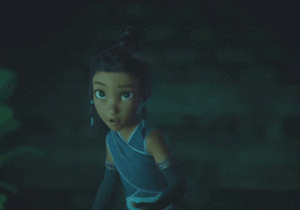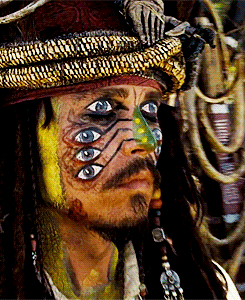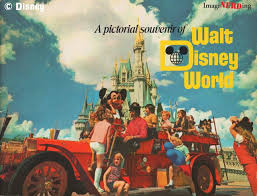No, this is not cheating. I know that I alisema that I wouldn’t review Lion King based on the fact that if it’s based on anything at all, it’s based on a play and not a book. And I also know that Peter Pan started out as a play. But: This play was so successful that Barrie also published a novel based on it. Plus, while the play made the figure Peter Pan well known, he actually turned up first in the novel The Little White Bird. See? Not cheating at all.
But it would be naturally strange to ignore the play – I’m a little bit at disadvantage here, though, because I’ve never seen it, and in my experience, it makes a big difference if wewe read a play au actually experience it. But I’ll try my best to include the most important aspects of it.
1. The World of Neverland
One of the changes most adaptions, including the Disney version, make is that they draw a clear distinction between Neverland and the real world. In the novel the lines are a little bit zaidi blurred, for example the Lost Boys are still sometimes flying after they come back. Personally I think a clear distinction is necessary, because if the “real world” described in the book is already unusual (well, zaidi unusual as having babysitting dogs), it makes it harder to believe that Neverland somehow exists in our “real world” too.
Disney creates a convincing version of Neverland, basically the land of imagination and childhood plays. It has a secret mti house, Mermaids, Pirates and Indians. Yeah, the Indians. I guess I should address the tembo in the room from the get go: If wewe see the Indians as Native American stereotypes, they are downright offensive, and the only excuse for them is that those stereotypes are not only en par with what was written kwa Barrie but also zaidi au less akin to what was shown in the very maarufu western sinema which were made in the 1950s. But I think wewe should see them as what they are supposed to be, not Native Americans, but the kind of Indians which tend to life in the imagination of children. Don’t blame Disney for this one. Blame Buffalo Bill with his Western show, blame Karl May, blame everyone who ever wrote a story about the “Wild West” without really knowing what he is talking about. I don’t think that the Indians would look au act like that if the movie were made nowadays, they would tone it down a bit. But I also think that realistic Native Americans wouldn’t fit into Neverland. It’s not like the Pirates are anything like the real ones either.
Another difference between the original and the Disney version is that in the novel, Neverland is treated like a real place. The children are gone for months, and when they come back, they bring the Lost boys with them, who are all getting adopted kwa their parents. But in the Disney movie, it’s strongly suggested that Neverland is born out of Wendy’s imagination. Not only does the narrator states from the get go that all children have a Neverland, Wendy also tells stories about Peter Pan before she even met him (and then notes that he looks exactly like she imagined him). And when she “comes back” (after just one night) she is initially found sleeping at the window kwa her parents.
2. The Characters
Barrie never described Peter Pan, nor did he specify his age. The Disney version has rather elfish features, and he wears green clothes instead of a dress made of leaves. And, like he is supposed to do, he is the embodiment of childhood. He is selfish, convinced of his own invincibility and has no sense for consequences whatsoever. Especially the scene with the mermaids drive this across, when he doesn’t see much harm in them trying to drown Wendy.
I guess this is the right moment to say something about the female characters. We have here a movie from the 1950s based on a story from the 1910s whose secondary main character is mostly praised for her motherly qualities. In this combination the best one would expect a fair for its time portrayal of the females. When it comes to the novel, it was zaidi than fair. For example the reason there are only Lost Boys and no Lost Girls is because supposedly Girls are too smart to getting lost. Wendy’s motherly traits are revelled, as are the other females. Aside from Peter Pan himself and naturally Captain Hook, the female character also get way zaidi attention.
And the Disney version isn’t that bad either. It keeps the aspect of honouring the mother role, but it also allows Wendy to draw the line. Looking out for her little brothers? Sure. Getting treated like some sort of servant while the boys are allowed to party? Now wewe are trying her patience. And when it comes down to it, the female characters in the movie are the truly brave ones. Peter might be the one who fights, but since he is convinced that he will win in every encounter, there isn’t much bravery behind it. Wendy on the other hand would rather go of the plank that betraying her principles. Tiger Lily would rather drown than giving away anything, even though she knows that this way of dying would keep her from reaching her afterlife. And Tinker Bell nearly dies when she rescues Peter from a bomb.
When it comes to the Lost boys and Wendy’s brothers – I can take them au leave them. They have just enough character to be not interchangeable, but they are neither particularly memorable nor important in the grand scheme of things. Same for Nana, though it’s certainly fun to watch her react to the situation in the family (and trying to rebuild the ngome again and again). This character is just made for a Disney movie (though I never really got the point of a dog which acts like a nanny…it’s just odd…).
Mr. Darling is an example of unintentional symbolic kwa the writer. In the original play, he and Captain Hook were portrayed kwa the same actor. The reason for this was simply economic use of resources, since the characters don’t share a scene, they needed one actor less this way. But since there is an undeniable symbolic in this arrangement, it has become tradition. In the Disney version the character designs are different, but the voices are the same. It also lays zaidi emphasis on the father than the mother, kwa making his role of the “kill-joy” zaidi extreme and his intention to remove Wendy from the play room the central conflict. In the original the mother is the zaidi important character. One symbol in the novel I was never really able to figure out is that she has a hidden kiss in the right corner of her mouth which Wendy could never reach. It’s apparently reserved for her husband. But at the end of the novel, Peter Pan takes this kiss with him.
Disney’s version of Captain Hook is easily one of the funniest villains in canon. His whole relationship with Smee and how they constantly play off each other as a comedic duo is entirely Disney (in the novel Smee is mostly notable because he is one of two pirates who survives, telling everyone that he was the only pirate Captain Hook feared). My favourite part is when Smee hammers a “don’t disturb sign” on the door because Hook has a headache (and everything which follows).
But Hook is also one of the most threatening ones. Partly because of his ubunifu and actions. Causally shooting one of his men, kidnapping and nearly killing Tiger Lily, how he fools Tinker Bell meanwhile pretending that he is all honourable (naturally he isn’t), there is no doubt that Hook is a dangerous man. In the play and the book, Neverland is a dangerous place in general. In the movie though, the chanzo of danger is usually Hook, even if it’s only indirectly.
3. The Plot
When it comes to the broad strokes of the original, the plot is zaidi au less the same. Wendy discovers Peter, attaches his shadow, the children learn to fly (fun fact: the only reason pixy dust was eventually included kwa Barrie was because originally children got hurt when they tried to fly after seeing the play), they travel to Neverland, experience a few adventures. Wendy nearly dies due to a scheme kwa Tinkerbell, Peter Pan rescues Tiger Lily’s live, and eventually Wendy and her brothers want to go nyumbani again but get captured. Peter survives a murder ploy kwa Hook thanks to Tinkerbell, and there is a final battle on the pirate ship. After this Peter brings Wendy and her brothers home.
The details though are sometimes fundamentally different, and not just because Disney naturally takes full advantage of the different medium. Memorable scenes in the play include a misunderstanding between Wendy and Peter which makes him believe that a thimble is a kiss (and the other way around), Tinker Bell drinking poison for Peter and surviving if the audience claps in the hands and shows that they believe in vichimbakazi and Hook getting eaten kwa the mamba in the end because the clock stopped ticking. In the movie, Wendy simply says that she wants to give Peter a kiss instead of a thimble (in both cases Tinker Bell interferes), instead of poison the murder ploy involves a bomb, how Tinker Bell survived isn’t quite clear since the clapping scene is omitted because Walt Disney didn’t think that this would work in a movie, and Hook doesn’t die, instead he is chased away.
The adventures of the children in Neverland have, especially in the novel, a very episodic character. Disney basically picked what they liked and rewrote is in a way that it works as an “it all happened in one night” story. The biggest change is that Wendy and the Lost Boys barely interact with each other in the movie. Peter introduces them to each other after they nearly killed Wendy due to Tinker Bell scheming against her, but then the group immediately mgawanyiko, baidisha up. Peter and Wendy explore the island together, while the boys (lost and otherwise) tafuta for their own adventure. The only scene in which there is meaningful interaction is when she later reminds them how great it is to have a real mother.
I already mentioned that the Lost Boys and Wendy’s brothers are not really that important. In the original they are mostly just along for the ride, the focus is on Wendy and Peter. That’s true for the movie too, and to be honest, I never enjoyed the part when the boys go “hunting Indians”. The song is annoying, there doesn’t really happen all that much and while the stereotypes don’t bother me unduly, the very idea that hunting people is an acceptable game (especially since John believes that this is for real) does. Even as a child I always felt uncomfortable watching this part.
Speaking of songs: They are quite a mixed package. The slow paced title song which is typical for the 1950s sinema has a nice enough tune, but the other songs have a childish aspect to it, not just in tone, but also in text. It’s not a bad fit for the movie, though, not at all, this is a children’s world after all, epic songs would just overwhelm it, but they sometimes slip too much into triviality. Ironically the song I consider the best is the controversial “What makes the red man red”. Just hear me out: I think it’s the best partly because it has a drive to it the other songs lack, but mostly because the mind-set behind Neverland is hit spot on in this. The swali which are asked in this are typical children’s maswali (along the line of “Why is the sky blue?”) and the majibu are children’s logic. It’s not unusual for children to make surprising leaps of logic, making connections between things which are not connected at all, and the song transports this perfectly.
The best scenes are naturally the ones with Hook. No matter if he interacts with Peter, Smee, the mamba au Tinkerbell, no matter if he is funny, threatening au both, whenever he turns up he owns the screen. If Disney’s depiction of him has one weakness than that kwa playing his fear of the mamba (and kwa extension the ticking clock) is played so much for fun that it distracts from him being basically afraid of time.
Disney simply ignores some of the symbolic aspects of the play and the novel, the odd ones as well as the zaidi straightforward ones. In the play and the novel Peter Pan is a somewhat tragic figure. He is trapped in childhood, not being able to songesha forward, partly because he keeps forgetting his past, because otherwise his mind would grow up. A part of him is constantly searching for some sort of mother figure, and his desire for one is so strong that he initially plans to convince Wendy to stay in Neverland through trickery, and changes his mind only when he sees the grief of Mrs. Darling. The play allows the audience to revisit the perspective of their youth, but it also makes clear that nobody can stay in Neverland forever. The play as well as the novel is very clear that Peter Pan is the only one who will never grow up (it’s also suggested that all the other inhabitants of Neverland eventually die, too – meaning that while Peter remains unchanged, the world around him moves forward).
The Disney version omits this tragic aspect. There the idea that Peter Pan will always be out there is zaidi a comforting one, as if a part of our childhood will always be there, no matter how old we are. Disney also lays zaidi emphasis on the conflict between Wendy and her father, ending it with them both changing their mind and him musing about having seen this ship before when he was still a child. This leads to his wife and daughter embracing him, a far cry from the way he is treated at the beginning of the movie – yes, he acts a little bit like a dick, but it’s also very uchungu, chungu if wewe fall through the whole room and your family only cares about the dog getting hurt. So while the “growing up” aspect is still there, there seems to be an even stronger message that one should never wholly forget his childhood perspective, no matter how old wewe are. Well, wewe are never really too old for Disney sinema either, right?
4. Merchandise
Yeah, I normally don’t have this category in my reviews, but I guess I should say something about Tinkerbell. For a classic Disney character she is unusual. Not only is she jealous, she also acts on this jealously two times. In the novel, those actions as well as Peter’s willingness to overlook them are explained with vichimbakazi not being able to have conflicted feelings. Since they are so small, they have only place for one feeling, meaning weather they upendo au hate, they always do it with full force. The movie omits this explanation, therefore Tinker Bell becomes quite a vindictive character. While her betrayal mostly happens because Hook manipulates her, she is very aware that it’s dangerous to deal with him. That she insist on Peter’s safety being part of the deal, but doesn’t seem to care for anyone else, is a very callous move.
Tinkerbell’s willingness to do everything for Peter but also to act against everyone who seems to get between them, makes her unique in the Disney canon. Normally those are character traits wewe would find in a villain, not in a sidekick. That she oozes sexuality on the other hand is not that uncommon, not really. Disney was never above getting kaa past the radar, she is just another example of this.
But one thing for sure: The Tinker Bell in Disney’s fairy franchise has nothing to do with the one in the original movie. Thus said, I don’t think that the franchise hurts anything. I guess it’s enjoyable enough for little (really little) children and easy enough to ignore.
5. The Conclusion
All in all, this is a solid but overly simplified take on the story. From today’s perspective the movie certainly has its problems, the character designs as well as the muziki are so clearly 1950s that it does look a little bit dated. But the strong point of the movie is the humour, and I’m saying this as someone who is usually not into slapstick at all: The comedic timing is just perfect, it’s impossible, not to laugh, and the best part is that none of the jokes are in any way referential, they are in-universe funny.
The downside of the movie is that it lacks depth, since the message is too anvilious and the plot too simple. It’s the play broken down to its very basic and never ventures out of the salama zone of family friendly entertainment. Therefore it’s zaidi fun for children to watch then for adults, even though they might enjoy the nostalgia, not just the nostalgia of watching something from their childhood, but also experiencing the mind-set of a child again.
But it would be naturally strange to ignore the play – I’m a little bit at disadvantage here, though, because I’ve never seen it, and in my experience, it makes a big difference if wewe read a play au actually experience it. But I’ll try my best to include the most important aspects of it.
1. The World of Neverland
One of the changes most adaptions, including the Disney version, make is that they draw a clear distinction between Neverland and the real world. In the novel the lines are a little bit zaidi blurred, for example the Lost Boys are still sometimes flying after they come back. Personally I think a clear distinction is necessary, because if the “real world” described in the book is already unusual (well, zaidi unusual as having babysitting dogs), it makes it harder to believe that Neverland somehow exists in our “real world” too.
Disney creates a convincing version of Neverland, basically the land of imagination and childhood plays. It has a secret mti house, Mermaids, Pirates and Indians. Yeah, the Indians. I guess I should address the tembo in the room from the get go: If wewe see the Indians as Native American stereotypes, they are downright offensive, and the only excuse for them is that those stereotypes are not only en par with what was written kwa Barrie but also zaidi au less akin to what was shown in the very maarufu western sinema which were made in the 1950s. But I think wewe should see them as what they are supposed to be, not Native Americans, but the kind of Indians which tend to life in the imagination of children. Don’t blame Disney for this one. Blame Buffalo Bill with his Western show, blame Karl May, blame everyone who ever wrote a story about the “Wild West” without really knowing what he is talking about. I don’t think that the Indians would look au act like that if the movie were made nowadays, they would tone it down a bit. But I also think that realistic Native Americans wouldn’t fit into Neverland. It’s not like the Pirates are anything like the real ones either.
Another difference between the original and the Disney version is that in the novel, Neverland is treated like a real place. The children are gone for months, and when they come back, they bring the Lost boys with them, who are all getting adopted kwa their parents. But in the Disney movie, it’s strongly suggested that Neverland is born out of Wendy’s imagination. Not only does the narrator states from the get go that all children have a Neverland, Wendy also tells stories about Peter Pan before she even met him (and then notes that he looks exactly like she imagined him). And when she “comes back” (after just one night) she is initially found sleeping at the window kwa her parents.
2. The Characters
Barrie never described Peter Pan, nor did he specify his age. The Disney version has rather elfish features, and he wears green clothes instead of a dress made of leaves. And, like he is supposed to do, he is the embodiment of childhood. He is selfish, convinced of his own invincibility and has no sense for consequences whatsoever. Especially the scene with the mermaids drive this across, when he doesn’t see much harm in them trying to drown Wendy.
I guess this is the right moment to say something about the female characters. We have here a movie from the 1950s based on a story from the 1910s whose secondary main character is mostly praised for her motherly qualities. In this combination the best one would expect a fair for its time portrayal of the females. When it comes to the novel, it was zaidi than fair. For example the reason there are only Lost Boys and no Lost Girls is because supposedly Girls are too smart to getting lost. Wendy’s motherly traits are revelled, as are the other females. Aside from Peter Pan himself and naturally Captain Hook, the female character also get way zaidi attention.
And the Disney version isn’t that bad either. It keeps the aspect of honouring the mother role, but it also allows Wendy to draw the line. Looking out for her little brothers? Sure. Getting treated like some sort of servant while the boys are allowed to party? Now wewe are trying her patience. And when it comes down to it, the female characters in the movie are the truly brave ones. Peter might be the one who fights, but since he is convinced that he will win in every encounter, there isn’t much bravery behind it. Wendy on the other hand would rather go of the plank that betraying her principles. Tiger Lily would rather drown than giving away anything, even though she knows that this way of dying would keep her from reaching her afterlife. And Tinker Bell nearly dies when she rescues Peter from a bomb.
When it comes to the Lost boys and Wendy’s brothers – I can take them au leave them. They have just enough character to be not interchangeable, but they are neither particularly memorable nor important in the grand scheme of things. Same for Nana, though it’s certainly fun to watch her react to the situation in the family (and trying to rebuild the ngome again and again). This character is just made for a Disney movie (though I never really got the point of a dog which acts like a nanny…it’s just odd…).
Mr. Darling is an example of unintentional symbolic kwa the writer. In the original play, he and Captain Hook were portrayed kwa the same actor. The reason for this was simply economic use of resources, since the characters don’t share a scene, they needed one actor less this way. But since there is an undeniable symbolic in this arrangement, it has become tradition. In the Disney version the character designs are different, but the voices are the same. It also lays zaidi emphasis on the father than the mother, kwa making his role of the “kill-joy” zaidi extreme and his intention to remove Wendy from the play room the central conflict. In the original the mother is the zaidi important character. One symbol in the novel I was never really able to figure out is that she has a hidden kiss in the right corner of her mouth which Wendy could never reach. It’s apparently reserved for her husband. But at the end of the novel, Peter Pan takes this kiss with him.
Disney’s version of Captain Hook is easily one of the funniest villains in canon. His whole relationship with Smee and how they constantly play off each other as a comedic duo is entirely Disney (in the novel Smee is mostly notable because he is one of two pirates who survives, telling everyone that he was the only pirate Captain Hook feared). My favourite part is when Smee hammers a “don’t disturb sign” on the door because Hook has a headache (and everything which follows).
But Hook is also one of the most threatening ones. Partly because of his ubunifu and actions. Causally shooting one of his men, kidnapping and nearly killing Tiger Lily, how he fools Tinker Bell meanwhile pretending that he is all honourable (naturally he isn’t), there is no doubt that Hook is a dangerous man. In the play and the book, Neverland is a dangerous place in general. In the movie though, the chanzo of danger is usually Hook, even if it’s only indirectly.
3. The Plot
When it comes to the broad strokes of the original, the plot is zaidi au less the same. Wendy discovers Peter, attaches his shadow, the children learn to fly (fun fact: the only reason pixy dust was eventually included kwa Barrie was because originally children got hurt when they tried to fly after seeing the play), they travel to Neverland, experience a few adventures. Wendy nearly dies due to a scheme kwa Tinkerbell, Peter Pan rescues Tiger Lily’s live, and eventually Wendy and her brothers want to go nyumbani again but get captured. Peter survives a murder ploy kwa Hook thanks to Tinkerbell, and there is a final battle on the pirate ship. After this Peter brings Wendy and her brothers home.
The details though are sometimes fundamentally different, and not just because Disney naturally takes full advantage of the different medium. Memorable scenes in the play include a misunderstanding between Wendy and Peter which makes him believe that a thimble is a kiss (and the other way around), Tinker Bell drinking poison for Peter and surviving if the audience claps in the hands and shows that they believe in vichimbakazi and Hook getting eaten kwa the mamba in the end because the clock stopped ticking. In the movie, Wendy simply says that she wants to give Peter a kiss instead of a thimble (in both cases Tinker Bell interferes), instead of poison the murder ploy involves a bomb, how Tinker Bell survived isn’t quite clear since the clapping scene is omitted because Walt Disney didn’t think that this would work in a movie, and Hook doesn’t die, instead he is chased away.
The adventures of the children in Neverland have, especially in the novel, a very episodic character. Disney basically picked what they liked and rewrote is in a way that it works as an “it all happened in one night” story. The biggest change is that Wendy and the Lost Boys barely interact with each other in the movie. Peter introduces them to each other after they nearly killed Wendy due to Tinker Bell scheming against her, but then the group immediately mgawanyiko, baidisha up. Peter and Wendy explore the island together, while the boys (lost and otherwise) tafuta for their own adventure. The only scene in which there is meaningful interaction is when she later reminds them how great it is to have a real mother.
I already mentioned that the Lost Boys and Wendy’s brothers are not really that important. In the original they are mostly just along for the ride, the focus is on Wendy and Peter. That’s true for the movie too, and to be honest, I never enjoyed the part when the boys go “hunting Indians”. The song is annoying, there doesn’t really happen all that much and while the stereotypes don’t bother me unduly, the very idea that hunting people is an acceptable game (especially since John believes that this is for real) does. Even as a child I always felt uncomfortable watching this part.
Speaking of songs: They are quite a mixed package. The slow paced title song which is typical for the 1950s sinema has a nice enough tune, but the other songs have a childish aspect to it, not just in tone, but also in text. It’s not a bad fit for the movie, though, not at all, this is a children’s world after all, epic songs would just overwhelm it, but they sometimes slip too much into triviality. Ironically the song I consider the best is the controversial “What makes the red man red”. Just hear me out: I think it’s the best partly because it has a drive to it the other songs lack, but mostly because the mind-set behind Neverland is hit spot on in this. The swali which are asked in this are typical children’s maswali (along the line of “Why is the sky blue?”) and the majibu are children’s logic. It’s not unusual for children to make surprising leaps of logic, making connections between things which are not connected at all, and the song transports this perfectly.
The best scenes are naturally the ones with Hook. No matter if he interacts with Peter, Smee, the mamba au Tinkerbell, no matter if he is funny, threatening au both, whenever he turns up he owns the screen. If Disney’s depiction of him has one weakness than that kwa playing his fear of the mamba (and kwa extension the ticking clock) is played so much for fun that it distracts from him being basically afraid of time.
Disney simply ignores some of the symbolic aspects of the play and the novel, the odd ones as well as the zaidi straightforward ones. In the play and the novel Peter Pan is a somewhat tragic figure. He is trapped in childhood, not being able to songesha forward, partly because he keeps forgetting his past, because otherwise his mind would grow up. A part of him is constantly searching for some sort of mother figure, and his desire for one is so strong that he initially plans to convince Wendy to stay in Neverland through trickery, and changes his mind only when he sees the grief of Mrs. Darling. The play allows the audience to revisit the perspective of their youth, but it also makes clear that nobody can stay in Neverland forever. The play as well as the novel is very clear that Peter Pan is the only one who will never grow up (it’s also suggested that all the other inhabitants of Neverland eventually die, too – meaning that while Peter remains unchanged, the world around him moves forward).
The Disney version omits this tragic aspect. There the idea that Peter Pan will always be out there is zaidi a comforting one, as if a part of our childhood will always be there, no matter how old we are. Disney also lays zaidi emphasis on the conflict between Wendy and her father, ending it with them both changing their mind and him musing about having seen this ship before when he was still a child. This leads to his wife and daughter embracing him, a far cry from the way he is treated at the beginning of the movie – yes, he acts a little bit like a dick, but it’s also very uchungu, chungu if wewe fall through the whole room and your family only cares about the dog getting hurt. So while the “growing up” aspect is still there, there seems to be an even stronger message that one should never wholly forget his childhood perspective, no matter how old wewe are. Well, wewe are never really too old for Disney sinema either, right?
4. Merchandise
Yeah, I normally don’t have this category in my reviews, but I guess I should say something about Tinkerbell. For a classic Disney character she is unusual. Not only is she jealous, she also acts on this jealously two times. In the novel, those actions as well as Peter’s willingness to overlook them are explained with vichimbakazi not being able to have conflicted feelings. Since they are so small, they have only place for one feeling, meaning weather they upendo au hate, they always do it with full force. The movie omits this explanation, therefore Tinker Bell becomes quite a vindictive character. While her betrayal mostly happens because Hook manipulates her, she is very aware that it’s dangerous to deal with him. That she insist on Peter’s safety being part of the deal, but doesn’t seem to care for anyone else, is a very callous move.
Tinkerbell’s willingness to do everything for Peter but also to act against everyone who seems to get between them, makes her unique in the Disney canon. Normally those are character traits wewe would find in a villain, not in a sidekick. That she oozes sexuality on the other hand is not that uncommon, not really. Disney was never above getting kaa past the radar, she is just another example of this.
But one thing for sure: The Tinker Bell in Disney’s fairy franchise has nothing to do with the one in the original movie. Thus said, I don’t think that the franchise hurts anything. I guess it’s enjoyable enough for little (really little) children and easy enough to ignore.
5. The Conclusion
All in all, this is a solid but overly simplified take on the story. From today’s perspective the movie certainly has its problems, the character designs as well as the muziki are so clearly 1950s that it does look a little bit dated. But the strong point of the movie is the humour, and I’m saying this as someone who is usually not into slapstick at all: The comedic timing is just perfect, it’s impossible, not to laugh, and the best part is that none of the jokes are in any way referential, they are in-universe funny.
The downside of the movie is that it lacks depth, since the message is too anvilious and the plot too simple. It’s the play broken down to its very basic and never ventures out of the salama zone of family friendly entertainment. Therefore it’s zaidi fun for children to watch then for adults, even though they might enjoy the nostalgia, not just the nostalgia of watching something from their childhood, but also experiencing the mind-set of a child again.
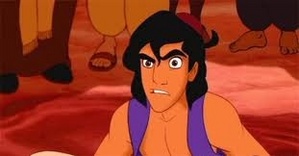
I hate this film now.


